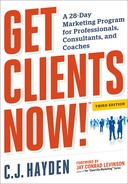Recipe: Following Up with New Contacts
If you don’t follow up with the new people you meet, you are wasting your time in meeting them. It is simply untrue that someone will “contact you when they need you.” The truth is that if they have met you only once, they probably don’t even remember you, and it’s even less likely that they will remember where to find you.
In networking, remembering the know-like-and-trust factor is critical. If you give people a chance to know you better, they will be much more likely to do business with you or refer others. But building relationships like this takes repeated contacts over time. There is much more about follow-up in Chapter 8, but the focus here is on how to follow up with new people you meet at live events or online.
When you return from attending a live event, sort all the new contacts you’ve collected into three categories: prospective clients, useful networking contacts, and other. Now sort the prospect category into hot, warm, and cool leads. A hot lead would be someone who already expressed an interest in doing business with you. A warm lead would be someone who mentioned a problem or goal you know you can help with.
Stop right there and follow up with all the hot and warm leads. Call each one on the phone, reintroduce yourself, and try to have a sales conversation or make an appointment for one. If directly soliciting business is inappropriate due to your profession (psychotherapy, for example) or the nature of the relationship (maybe it’s your child’s teacher), you can still make contact, perhaps by sending a “nice-to-meet-you” note. When you get voice mail or someone requests more information, send a letter or e-mail with a fact sheet or link to your website. For all your new contacts, capture them in your contact management system to keep track of their contact information and prompt you when to follow up again. If you use a broadcast e-mail system for follow-up, you might also capture them there, with their permission. You may also wish to add them to your social media network by requesting to connect or following them.
Next, go to the useful networking contacts and sort them into two categories: people whom you believe can lead you directly to prospective clients and people who can lead you to other marketing opportunities, such as a new networking group or a speaking engagement. Stop and follow up with the people who might ultimately have leads for you. Call them to suggest coffee or lunch, or offer to stop by the office. Remember your intention to build an ongoing relationship. Listen for clues about their interests, concerns, and goals. Consider what you might be able to offer them to create some reciprocity in your relationship. Then capture them in your contact management system for later follow-up.
You should now have three groups left: cool client leads, people who can lead you to marketing opportunities, and other. If you are short on time or have other hot leads in the pipeline, send those cool leads a nice-to-meet-you note, and tuck them away in your contact management system in case you need them later. If the new marketing opportunities fit into your current plans, go ahead and contact those people. Otherwise treat them just like the cool leads.
And those people in the “other” group? Unless they belong to people you would like to have a personal friendship with, toss them out. If they aren’t worth following up with now, they don’t belong in your contact management system.
With new contacts you meet online, it’s also important to categorize and track them so you can follow up appropriately. Once online acquaintances have asked about working with you or otherwise shown interest in what you offer, it’s appropriate to capture their information from the online venue where you met them and enter them into your contact management system for future follow-up. Until they express this interest, however, many online community members consider it a breach of protocol to directly approach fellow members as prospects. Some online communities expressly forbid any unsolicited selling to other members, so make sure you stay within community guidelines.
The best way to convert your network members from online acquaintances to true prospects or referral sources is to be an active participant in the network. On social media networks, post updates regularly, and make sure to provide helpful or entertaining content, not just promotional messages. Comment on the updates posted by other members as well. On message boards and discussion groups, reply to queries from other members with relevant, useful information. On blogs, comment on the original post, or in response to comments posted by others.
Before participating in any online forum, spend some time observing how the existing members tend to communicate. When you have a good sense of the accepted protocol, start making your own contributions. Remember that your goal in online networking is the same as for any other networking environment: building relationships. Serving as a helpful resource and getting to know people better over time will further your marketing goals. Using the community as another advertising medium for your marketing messages will not get you clients, and may even get you banned from membership.
